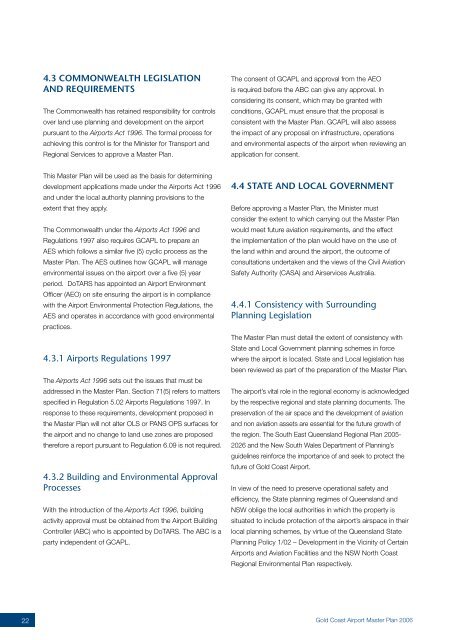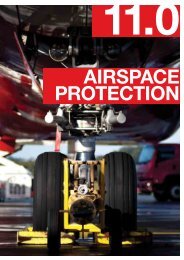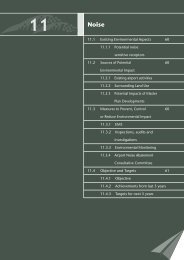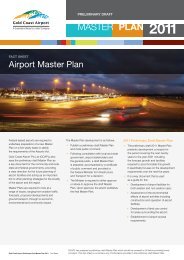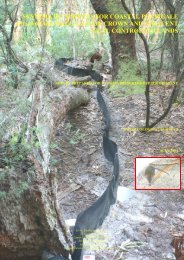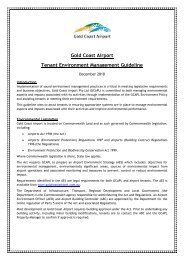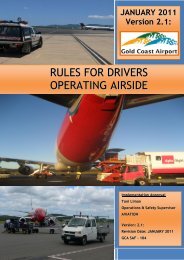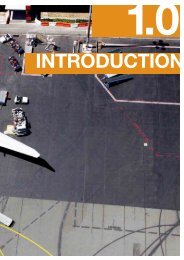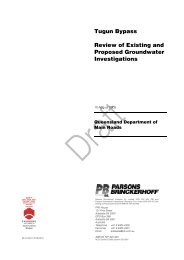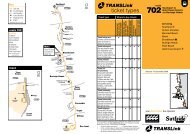Master Plan 2006 - Gold Coast Airport
Master Plan 2006 - Gold Coast Airport
Master Plan 2006 - Gold Coast Airport
Create successful ePaper yourself
Turn your PDF publications into a flip-book with our unique Google optimized e-Paper software.
4.3 COMMONWEALTH LEGISLATION<br />
AND REQUIREMENTS<br />
The Commonwealth has retained responsibility for controls<br />
over land use planning and development on the airport<br />
pursuant to the <strong>Airport</strong>s Act 1996. The formal process for<br />
achieving this control is for the Minister for Transport and<br />
Regional Services to approve a <strong>Master</strong> <strong>Plan</strong>.<br />
The consent of GCAPL and approval from the AEO<br />
is required before the ABC can give any approval. In<br />
considering its consent, which may be granted with<br />
conditions, GCAPL must ensure that the proposal is<br />
consistent with the <strong>Master</strong> <strong>Plan</strong>. GCAPL will also assess<br />
the impact of any proposal on infrastructure, operations<br />
and environmental aspects of the airport when reviewing an<br />
application for consent.<br />
This <strong>Master</strong> <strong>Plan</strong> will be used as the basis for determining<br />
development applications made under the <strong>Airport</strong>s Act 1996<br />
and under the local authority planning provisions to the<br />
extent that they apply.<br />
The Commonwealth under the <strong>Airport</strong>s Act 1996 and<br />
Regulations 1997 also requires GCAPL to prepare an<br />
AES which follows a similar five (5) cyclic process as the<br />
<strong>Master</strong> <strong>Plan</strong>. The AES outlines how GCAPL will manage<br />
environmental issues on the airport over a five (5) year<br />
period. DoTARS has appointed an <strong>Airport</strong> Environment<br />
Officer (AEO) on site ensuring the airport is in compliance<br />
with the <strong>Airport</strong> Environmental Protection Regulations, the<br />
AES and operates in accordance with good environmental<br />
practices.<br />
4.3.1 <strong>Airport</strong>s Regulations 1997<br />
The <strong>Airport</strong>s Act 1996 sets out the issues that must be<br />
addressed in the <strong>Master</strong> <strong>Plan</strong>. Section 71(5) refers to matters<br />
specified in Regulation 5.02 <strong>Airport</strong>s Regulations 1997. In<br />
response to these requirements, development proposed in<br />
the <strong>Master</strong> <strong>Plan</strong> will not alter OLS or PANS OPS surfaces for<br />
the airport and no change to land use zones are proposed<br />
therefore a report pursuant to Regulation 6.09 is not required.<br />
4.3.2 Building and Environmental Approval<br />
Processes<br />
With the introduction of the <strong>Airport</strong>s Act 1996, building<br />
activity approval must be obtained from the <strong>Airport</strong> Building<br />
Controller (ABC) who is appointed by DoTARS. The ABC is a<br />
party independent of GCAPL.<br />
4.4 STATE AND LOCAL GOVERNMENT<br />
Before approving a <strong>Master</strong> <strong>Plan</strong>, the Minister must<br />
consider the extent to which carrying out the <strong>Master</strong> <strong>Plan</strong><br />
would meet future aviation requirements, and the effect<br />
the implementation of the plan would have on the use of<br />
the land within and around the airport, the outcome of<br />
consultations undertaken and the views of the Civil Aviation<br />
Safety Authority (CASA) and Airservices Australia.<br />
4.4.1 Consistency with Surrounding<br />
<strong>Plan</strong>ning Legislation<br />
The <strong>Master</strong> <strong>Plan</strong> must detail the extent of consistency with<br />
State and Local Government planning schemes in force<br />
where the airport is located. State and Local legislation has<br />
been reviewed as part of the preparation of the <strong>Master</strong> <strong>Plan</strong>.<br />
The airport’s vital role in the regional economy is acknowledged<br />
by the respective regional and state planning documents. The<br />
preservation of the air space and the development of aviation<br />
and non aviation assets are essential for the future growth of<br />
the region. The South East Queensland Regional <strong>Plan</strong> 2005-<br />
2026 and the New South Wales Department of <strong>Plan</strong>ning’s<br />
guidelines reinforce the importance of and seek to protect the<br />
future of <strong>Gold</strong> <strong>Coast</strong> <strong>Airport</strong>.<br />
In view of the need to preserve operational safety and<br />
efficiency, the State planning regimes of Queensland and<br />
NSW oblige the local authorities in which the property is<br />
situated to include protection of the airport’s airspace in their<br />
local planning schemes, by virtue of the Queensland State<br />
<strong>Plan</strong>ning Policy 1/02 – Development in the Vicinity of Certain<br />
<strong>Airport</strong>s and Aviation Facilities and the NSW North <strong>Coast</strong><br />
Regional Environmental <strong>Plan</strong> respectively.<br />
22 <strong>Gold</strong> <strong>Coast</strong> <strong>Airport</strong> <strong>Master</strong> <strong>Plan</strong> <strong>2006</strong>


